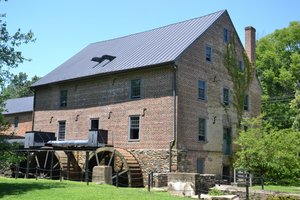Advertisement
Published: July 15th 2019

 Aldie Mill
Aldie Mill
Aldie Mill (1807) and its twin water wheels.
DSC_0193We visited Aldie Mill in Loudoun County for a weekend daytrip. It's located in Aldie, a village on US Highway 50 in Loudoun County, Virginia, near Middleburg. The mill on the Little River was built in 1807 and continued in operation to 1971. I recalled seeing it in the 1980s when it was closed and falling into disrepair. Now restored as a park with demonstrations of 19th century grain milling, we decided to make a visit. The restored mill is open on Saturdays and Sundays when volunteers give tour and milling demonstrations
Aldie mill is unique among gristmills in Virginia in that it has two water wheels. I learned there were actually two mills on the site. One was the commercial mill that ground corn and wheat for sale while the other was the country or "private" mill, where farmers could bring their grain and do their own milling. Only the larger commercial mill is open and operating today. The two volunteer docents were very informative. One described and demonstrated the milling machinery and the workings of the mill. The millstones had been imported from France in the early 19th century. (They were shipped in triangular pieces, like slices of

 Water Wheel
Water Wheel
Water wheel at Aldie Mill.
DSC_0202a pie.) This was common for American mills of that era, we were told.
I'm always impressed with pre-steam and electric industrial technology. Everything is manual and analog, yet works in concert, The twin overshot water wheels can be turned on and off. When on, the water wheel rotates a series of gears that transfer water power to the millstones above. The speed, amount of grain to be fed and granularity of the product can all be controlled by the miller. Allow in too much grain and the stones will clog and "grind to a halt". An elevator system takes the ground mean or flour up to the third level when it is collected and bagged. The docent demonstrated grinding corn into a coarse cornmeal to be used for chickenfeed. It was the best explanation of 19th century milling that I have heard.
On the way home, we stopped at the nearby Mt. Zion Primitive Baptist Church historic site. Built in 1851, the church was in use until 1980. The churchyard continues to be in use. The vicinity saw some activity during the Civil War with skirmished between Union forces and Mosby's Rangers with the church building put
to use in various ways as a shelter and field hospital. The church was not open to visit. (Civil War graffiti is said to be present inside.) The design, a two-story rectangular brick edifice, reminded me very much of many Colonial era Anglican (now Episcopal) churches in Virginia.
Advertisement
Tot: 0.257s; Tpl: 0.011s; cc: 24; qc: 81; dbt: 0.119s; 1; m:domysql w:travelblog (10.17.0.13); sld: 1;
; mem: 1.2mb

 Aldie Mill
Aldie Mill
 Water Wheel
Water Wheel




